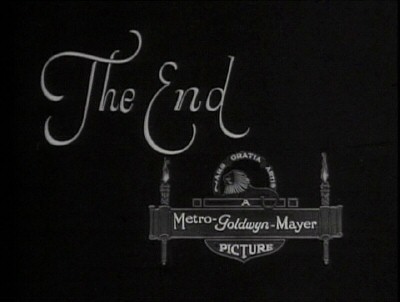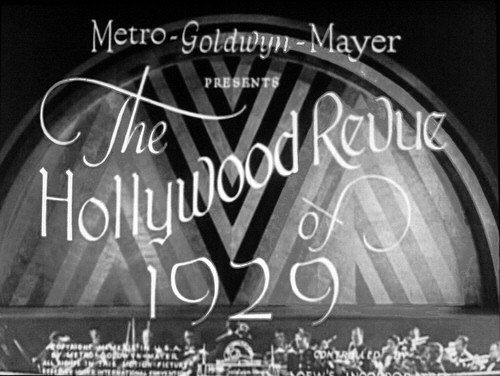

The Best of Everything
Encyclopedia Entry • Films Main
The Hollywood Revue of 1929


Critics' Reviews • Our Reviews • Movie Posters • Lobby Cards • Misc. Images
Click here to see photos from the film.
US general release: 11/23/29 (premiere 8/14/29). Warner Archive DVD release: 12/01/09. Cast: Conrad Nagel, Bessie Love, Joan Crawford, William Haines, Buster Keaton, Anita Page, Karl Dane, George K. Arthur, Gwen Lee, Ernest Belcher's Dancing Tots, Marie Dressler, Marion Davies, Cliff Edwards, Charles King, Polly Moran, Gus Edwards, Lionel Barrymore, Jack Benny, Brox Sisters, the Albertina Rasch Ballet, Natacha Natova and Company, the Rounders, Norma Shearer, John Gilbert, Laurel and Hardy. Credits: Dialogue: Al Boasberg and Robert Hopkins. Producer: Harry Rapf. Director: Charles F. Reisner. Camera: John Arnold, Irving G. Reis, and Maximilian Fabian. Art Direction: Cedric Gibbons and Richard Day. Music and Lyrics: Gus Edwards, Joe Goodwin, Nacio Herb Brown, Arthur Freed, Dave Snell, Louis Alter, Jessie Greer, Ray Klages, Martin Broones, Fred Fisher, Jo Trent, Avy Rice, Ballard MacDonald. Orchestra and Musical Score: Arthur Lange. Costumes: David Cox. Dances and Ensembles: Sammy Lee. Editor: William Gray.
Plot Summary: With the arrival of talkies, every major studio hopped on the musical bandwagon by turning out lavish "revues," spotlighting their top stars performing specialty numbers. MGM's entry in this all-star genre was Hollywood Revue of 1929, which, though a box-office smash and a "Best Picture" Oscar nominee, is an absolutely deadly experience when seen today. Even so, it coasts by on its curiosity value, as several major MGM luminaries display their all-talking, all-singing, all-dancing talents (or lack of same). The film is hosted by Conrad Nagel and Jack Benny, the latter still purveying the "wise-guy" personality he used on screen before adopting his more likable radio characterization. Some of the individual acts are modestly entertaining: Joan Crawford, the top of her head cut off due to faulty camerawork, is quite appealing in a jazz number; Laurel and Hardy and Buster Keaton provide genuine laughs, the former in a makeshift magic act and the latter performing a burlesque ballet; Bessie Love and Marion Davies are cute and cuddly in their respective musical numbers, while Marie Dressler is outrageously funny in her brace of appearances; and, best of all, Cliff Edwards solemnly introduces MGM's "signature" tune "Singin' in the Rain," which serves as a leitmotif throughout the picture. Other "highlights" are more impressive for their concept than their actual execution: Gus Edwards' "Lon Chaney Will Get You if You Don't Find Out" would have been more interesting had the real Lon Chaney Sr. made an appearance (something he reportedly refused to do), while John Gilbert and Norma Shearer's "slang" version of the balcony scene in Romeo and Juliet (a sequence filmed in Technicolor) produces winces rather than laughs. At that, these scenes are easier to digest than the wretched sentimental ballad "Your Mother and Mine," performed ad nauseum by the otherwise reliable Charles King, and the overproduced and under-rehearsed Orange Blossom finale (also in color). Long available only in its 82-minute TV release version, Hollywood Revue of 1929 was restored to nearly its original 125-minute length in the 1970s; the film is worth seeing once for historical purposes, but is hardly a "keeper," even for the most diligent of video collectors. ~ Hal Erickson, All Movie Guide
Awards: 1930 Oscar Nomination: Best Picture.
|
Mordaunt Hall in the New York Times August 15, 1929
Brimming over with good fun and catchy music, Metro-Goldwyn-Mayer's ambitious audible picture, "The Hollywood Revue," which was launched last night with the usual blaze of lights at the Astor Theatre, won frequent outbursts of genuine applause. It is a talking and singing film free from irritating outpourings of coarse slang or a tedious, sobbing romance. A light-hearted piece of work is this production. It trots gayly along from beginning to end with a wonderful fund of amusement and its clever and lavish staging is enhanced by imaginative camera work. It all may be but mere shadows, but nevertheless these sketches are never tedious. This "Hollywood Revue," which had a long run at the Chinese Theatre in Hollywood, where it was viewed by many thousands, has been produced with an unfailing sense of humor, and while there are moments when the film centre's pronunciation of words pops up, this does not interfere with the excellent entertainment value. Most of it is in black and white photography, but there are two beautiful color sequences that are something for the eye to feast upon. Even the master of ceremonies, usually so exasperating in his patronizing efforts in cinemas, helps along the clowning, even to having his shirt and waist-coat torn off him by William Haines. During one dance which is filmed by the Technicolor process the faint perfume of orange blossoms arises to one's nostrils. It is something that was introduced with this audible offering during its run in Hollywood. All the stellar lights in this gleeful series of shadows share and share alike. They all contribute unfailingly to the arousing of smiles, chuckles and laughter. It has no story, which is to its credit, for every one of its sketches that come to the screen leave one hungry for more. It is not a piece of work to cause drowsiness, for the wide-awake conduct of its participants is contagious. In a song by Gus Edwards, "Lon Chaney Will Get You if You Don't Watch Out," there is melody and merriment. Girls are seen in cots as Mr. Edwards sings and soon there comes to view a good many figures of characters of Mr. Chaney's past performances. Charles King sings nicely a tune called "Your Mother and Mine," and Marie Dressler delivers a hilarious bit when she warbles, "For I'm the Queen." The first prismatic episode opens up with Norma Shearer and John Gilbert in the balcony scene from "Romeo and Juliet." It is played seriously and Miss Shearer is charming, but suddenly, when the audience doesn't expect it, one hears the voice of the director shout: "Cut." It is then decided to give this Shakesperian morsel in modern argot, and while "boy-friend" and other colloquialisms are employed, there is nothing that savors of anything harsh. Buster Keaton is called upon to do some stunts in a submarine scene. Through his gauzy, grotesque costume one perceives that he has not forgotten to break the Volstead act, for dangling from his hips are his flasks. Marion Davies appears with a chorus of men dressed as Grenadier Guards. At first she is a lilliputian figure among brobdingnagian soldiers, but in a subsequent scene she grows up to natural size. The same fascinating photographic idea is employed when Bessie Love is first introduced, for Jack Benny, who officiates part of the time as master of ceremonies, calls to her to find out where she is, and even he is supposed to be somewhat surprised that she has got into the pocket where he keeps his money. She steps out of the pocket and soon is beheld on Mr. Benny's hand. She does her growing up through expert camera work and then she entertains with a recitative song. Conrad Nagel appears as the other master of ceremonies and in the course of his performance he is presumed to astonish Charles King by singing a song Mr. King rendered successfully in "The Broadway Melody." Gradually one perceives Mr. King dwindle until he is a mite in a huge chair, from which he leaps and makes himself scarce, for he had boasted that vocal films were for his ilk and not for the screen players. In some of the scenes there is a good deal of nonsense, but it is hitched up to a snappy end, so that, one forgets the boisterousness in enjoying the more favored humor. "Singin' in the Rain," is a song that is pleasingly delivered and charmingly staged. "Marie, Polly and Bess," with Marie Dressler, Polly Moran and Bessie Love, is another worth-while tit-bit, and following that there is "Strolling Thru The Park One Day," with Messrs. King, Ukulele Ike, Mr. Edwards, Miss Dressler, Miss Moran and Miss Love. There are moments when this picture is so good that one wishes it were a trifle more whimsical or sophisticated, for it does sometimes seem as though it is good enough to be even better. More might possibly have been accomplished with an episode, designated "Magicians," which calls to mind Chaplin's clever work in this particular line in his comedy, "The Circus." Stan Laurel and Oliver Hardy prove themselves in this offering to be thoroughly competent players and, when one of them flops on a great cake covered with icing, an otherwise promising piece of work winds up as mere slapstick. But the audience laughed and laughed still louder when Mr. Benny, after the cake had been pitched into the wings, comes forth covered with sticky whiteness. "The Hollywood Revue" will afford pleasure to the feminine patrons. It also will make men forget business, and children will be glad when their parents make the excuse that they are going to see "The Hollywood Revue" to "give the youngsters some fun."
Mark Hellinger in the New York Daily News (1929): If this film doesn't catch on like wildfire, I am Calvin Coolidge's old electric horse. As an example of what the talking film has done to the legitimate theatre, this Hollywood Revue is pretty nearly the last word. I urge Flo and Earl and George and Lee and Jake to take a look at it as soon as possible... It will give them plenty to think about.
Eleanor Barnes in the Los Angeles News (1929): Joan Crawford's popularity with the collegiate crowd is understandable. Joan is the spirit of youth. And her manner of singing "I've Got a Feeling for You"--coupled with her dancing to music furnished by the Biltmore quartet, was a radium drop for the bill.
TV Guide online: A showcase for MGM's enormous stable of stars, Hollywood Revue was at least in part designed to prove that MGM's stars could talk (and sing) with the best of them, since the studio was a bit slow to get on the sound-technology bandwagon. Individual sequences vary wildly in quality, but overall it's an astonishing time capsule of early motion-picture talent, much of which fell by the wayside in the '30s. |
If you've seen Hollywood Revue of 1929 and would like to share your review here, please e-mail me. Include a photo of yourself or avatar to accompany your review, as well as a star-rating (with 5 stars the best), and any of your favorite lines from the film.
|
Rating:
Conrad
Nagel: ...she's the personification of youth and beauty and joy and happiness: Joan Crawford. Joan: That's awfully kind of you, Conrad. Thank you.Yes, Conrad, on behalf of fans of early Joan Crawford, thank you for pointing out what we already knew! For those who know only the Crawford caricature or of her later work, the above introduction by Nagel may come as a surprise. Nagel was an established MGM matinee idol and one of two MCs---the other is Jack Benny in his film debut---for The Hollywood Revue of 1929, which gave Joan's fans the first opportunity to hear her speak on film. And sing! She dances, too, but that was old hat for Joanie by 1929. This Joan highlight comes early, at a bit past 6 minutes in. One can only imagine that, like many stars, Joan was nervous about how she'd sound on the new technology, and was asked to not just speak but also sing in her debut. (Wow, must have been a lot of anxious practicing at El Jodo!) That's a big ask, but Joan pulls it off. She sings "Got a Feeling For You," first alone and then accompanied by the Biltmore Quartet. In between, Joan does a very energetic bit of hoofing, reminiscent of her dance from the "brush-off" scene in Dancing Lady, or the hillbilly dance in The Laughing Sinners,etc. It may look ungainly to modern eyes, but one assumes that Joan's kind of dancing was darb with the kids back in the late '20s. MGM boasted of having more stars than there were in the heavens, but until Revue, an early MGM talkie, those stars largely twinkled silently in darkened movie houses. One presumes Revue was envisaged to show off the vocal talents of MGM stars at the dawn of talking cinema. And, in fact, just about every contract player on the MGM lot appears. This movie, not a "movie" in the traditional sense, is a mish-mash of mostly song and dance numbers with minor dramatics interspersed. Joan is also briefly in the final scene, an ensemble piece, performing "Singing in the Rain" by Nacio Herb Brown, which went on to be the inspiration for the famous 1952 musical. (Brown also wrote "Chant of the Jungle" for Joan's first talkie starring role in Untamed, 1929, and the excellent "All I Do is Dream of You" from Sadie McKee, 1934).
A lot of online snippets and thumbnails of this movie highlight Joan's small part. Indeed, most of the stars of Revue have largely faded from memory for all but the most ardent cinephiles, with the exception of Joan and perhaps Laurel and Hardy. However, The Hollywood Revue of 1929 was a huge hit in 1929 and was nominated for a Best Picture Oscar. As a cinematic time capsule, it's very interesting. But, I'm not gonna lie: This movie is a long 2 hours, and I've not watched much beyond Joan's parts. The few non-Joan skits that I've seen, like the Jack Benny-Billie Haines scene and Norma Shearer & John Gilbert doing a takeoff of Romeo & Juliet, are flat.
2 stars, and those largely for the fact that it was a chance for the movie-going public to hear Joan speak, and for Joan to show she was going to be a triple threat in the talkie era.
Rating:
Three stars for even trying to make this film. If I were there in 1929 I would have loved it. All talking and all shrinking! (A miniature Bessie Love!) The talkies were very fresh and this is a variety show, not a movie. Many talented and famous people of the entertainment world and MGM were involved: I think that is where Judy Garland and Mickey Rooney would say “Gee, let's put on a show!” “My dad says we can have the garage!”
The producer Harry Rapf put on the show and assembled the writers, technicians, special effects, sound people, lyricists, three cameramen, dialogue people, art directors, orchestra and 12 people working on the musical score... and don’t forget the costumes. It was a factory after all, but what a product!
There are many famous actors and entertainers appearing in the show, many fresh from Broadway or what was left of vaudeville; they were introducing their acts to the new audiences that sound provided. What a thrill to see and hear all of this wonderful entertainment. And Joan gets to hang with Buster Keaton!
Most of the actors and performers Joan would know for the rest of her life. Some of the people she performed with here she'd work with again in the future. There is a fantastic history going here:
Polly Moran also appeared in Paid. Gwen Lee appeared with Joan in other movies, as did Anita Page and Lionel Barrymore. William Haines and Joan remained life-long friends. Bessie Love had a cameo/bit in Esther Costello in 1957. Marion Davies came to Joan’s wedding party to Alfred Steele wearing tennis shoes under white ermine and white diamonds in 1955. Jack Benny and Joan would work with the Cancer Society in the '60s. Many others in the technical line would stay on at MGM until the early '60s. Cliff Edwards also appeared in Montana Moon in 1930, and Laughing Sinners and Dance, Fools, Dance in 1931 He was also the first to introduce "Singin' in the Rain," a Broadway favorite.
When you are really bored, give this picture a viewing and treat it like a variety show.
Rating:
"A nice little historical snapshot of state-of-the-art entertainment in 1929" --- I had to keep telling myself that as the movie creaked on...and on...
This is MGM's talking picture debut, and they throw in everything, everyone, and the kitchen sink in an effort to prove that they're on the cutting edge of this newfangled "talkie stuff." Most of their biggest stars are on hand (Joan, William Haines, Norma Shearer, Marion Davies, John Gilbert, Lionel Barrymore, Marie Dressler, Laurel and Hardy, Anita Page), with the notable exceptions of Garbo, Lon Chaney (though the "Lon Chaney's Gonna Get You If You Don't Watch Out" number is devoted to him), and some foreign leading men like Nils Asther and Ramon Novarro, who presumably hadn't perfected their English enough to be allowed to speak in MGM-public yet.
MGM is apparently attempting to unite stage and screen here---several mentions are made of stage and screen stars being "the best of friends." As the "revue" in the title suggests, there's no plot, just a series of performers doing mostly schticky stage acts sandwiched in between chorus numbers. Jack Benny is wry and relatively "Modern" (an issue that comes up relatively often in the proceedings) as the MC of the show, and he's assisted occasionally by Conrad Nagel, who gets to suavely announce a few acts and sing, suavely, to Anita Page.
Joan, just months past her huge Our Dancing Daughters hit, is the first star to perform a number, six minutes into the film. Nagel introduces her with "Here's one of my favorites, and I know you like her, too. Because she's the personification of youth and beauty and joy and happiness." Joan, standing beside a piano, replies "That's awfully kind of you, Conrad. Thank you." And then launches into a slow, beaming rendition of "I've Got a Feeling For You." Then the tempo picks up, the Biltmore Quartet appears, and Joan starts energetically hoofin' to the song with their accompaniment. At the end of the number, she hops onto the piano and is wheeled out with a snappy smile.
In a review of the film that I found in the Films of Joan Crawford book, an LA critic at the time wrote: "Joan Crawford's popularity with the collegiate crowd is understandable. Joan is the spirit of youth. And her manner of singing...coupled with her dancing...was a radium drop for the bill." Not that I have any idea what "radium drop" means, but Joan is indeed a bright, refreshing presence in the midst of the rest of the primarily old-fashioned attempts at entertainment. While almost everyone else tries far too hard to "put on a show" according to the apparently still-vaudevillian dictates of what a "show" might be, Joan simply turns on the charm and smiles and dances her heart out in an indeed thoroughly modern display of pure non-schticky and non-prop-reliant charisma.
MGM gets a bit schizophrenic here: Are they after the "Moderns" or the "Old Folks at Home" or the "Middle-Aged Folks at Home Still Trying to Keep Up"? All of the above, obviously. In the pure "Old Folks" camp is Charles King singing the incredibly hokey, Al Jolson-inspired "Your Mother and Mine." In the "Modern" category: Joan's number and Buster Keaton's wildly spasmodic (and hilarious) underwater "Salome" dance before King Neptune, as well as a few of the more scantily clad chorus numbers. In the "Wannabe" category is Norma Shearer and John Gilbert's switchover from a straight "Romeo and Juliet" scene to a "Modern"-lingo version of the play called "The Neckers," complete with Gilbert's Romeo saying "So long!" to his Juliet. (This all sounds like a clever idea, but the bit tries way too hard to be clever and reminds me of Steve Allen's deadpan reciting of Beatles' lyrics for a decidedly middle-class, middle-aged TV audience in the '60s.) Also in the "trying too hard to be hip"/stupidly dadaesque category: Really, why does William Haines have to eat various parts of Jack Benny's costume? It's one of those "so what" moments that's more dull than daring.
Despite the avowed early attempt at linking stage and screen, MGM also throws in a few technological bells and whistles to show where the real future lies: In the very first chorus number, half the dancers are in blackface, so the fancy new negative photography can subsequently reverse the blackface to white. There are also several bits where a performer is shrunken, to fit in a pocket, or dance atop a drum, or slide out of a chair. Plus some rudimentary colorization, for the "Romeo and Juliet" scene as well as the final "Singing in the Rain" number.
Occasional newfangled gimmicks notwithstanding, MGM still relies far too heavily on tired stage techniques. An example is the often interminable gap between scenes while we watch the curtain close and wait for the next act to appear. I know that by 1929, MGM had put out enough silent pictures to be adept, at least, at the art of cutting! (Seriously---I wasn't asking for anything fancy. Just...not the entire traversal of the curtain and the performer subsequently walking to his or her mark, with loooong seconds of dead silence. This is film, by gum!)
All said, while I in 2005 found 90% of "Revue" boring to the point of near-shrieking, it was, nonetheless, a huge box-office hit upon its release---indicative of its appeal to a 1929 audience dying to see how its favorite MGM stars would weather the at-the-time current "talkie storm" and/or still clinging to memories of stage shows that they were familiar with. Today, definitely not for any general viewer, but a necessary piece of arcana for the Joan or MGM or early film buff.
|
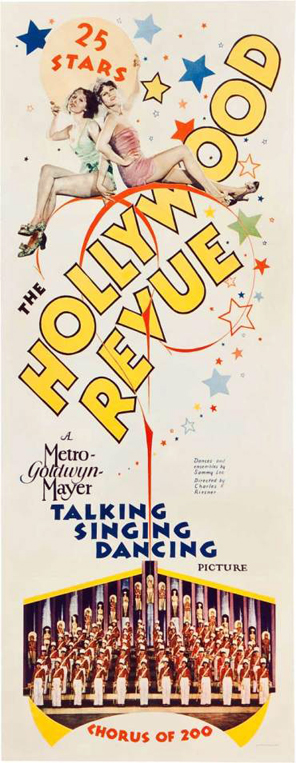
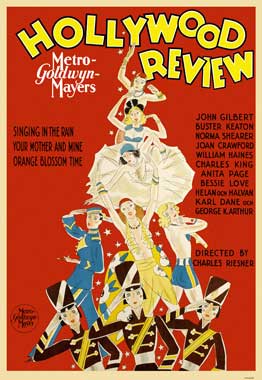
Above: Two from US.
Below: From Argentina, Scandinavia, and Belgium.
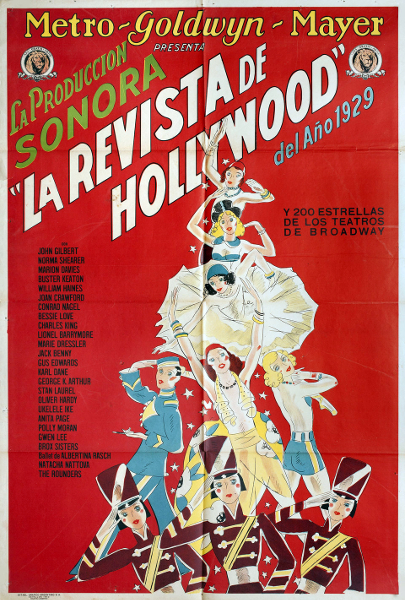
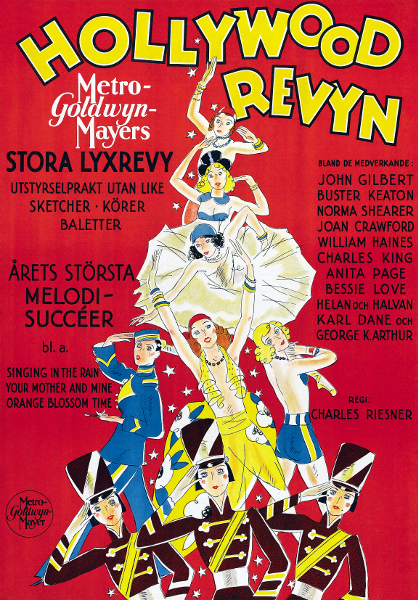
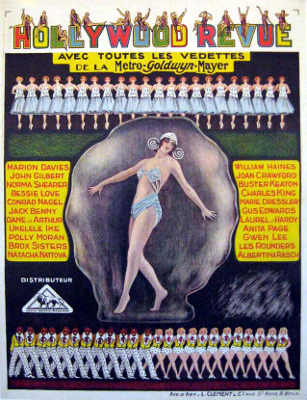
Below: US lobby cards.
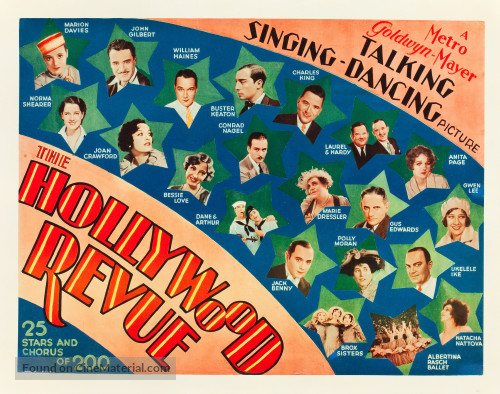
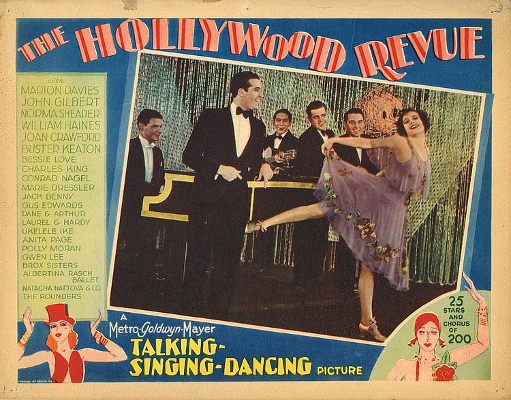

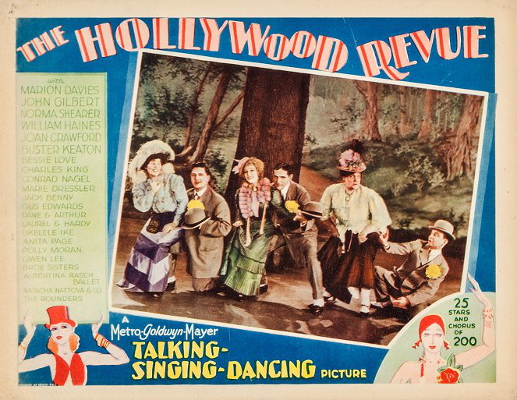
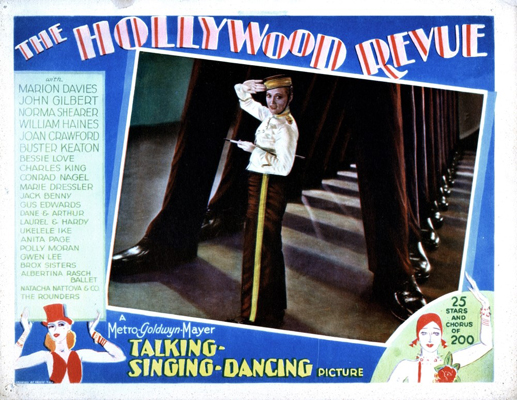

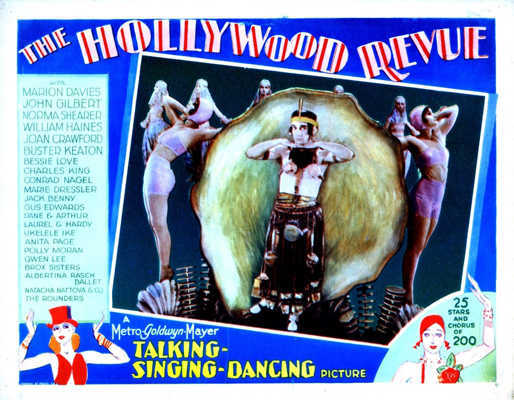
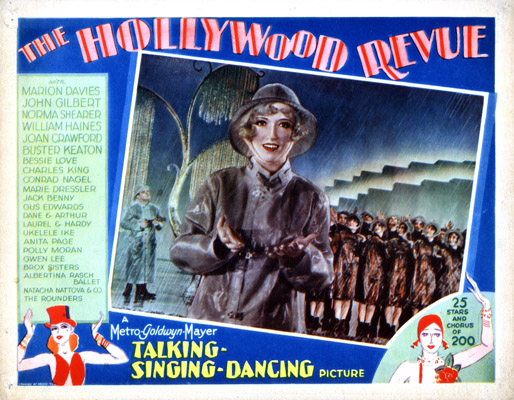
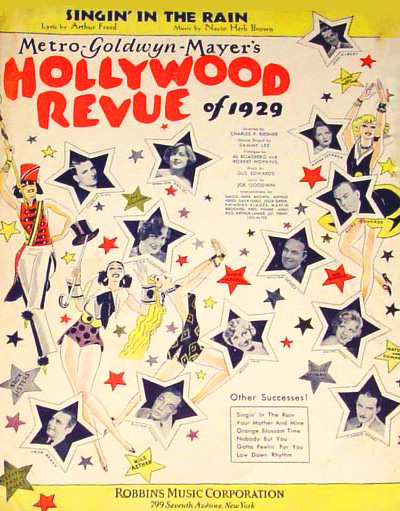
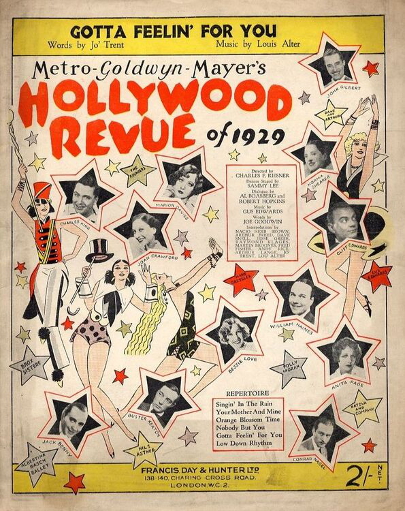
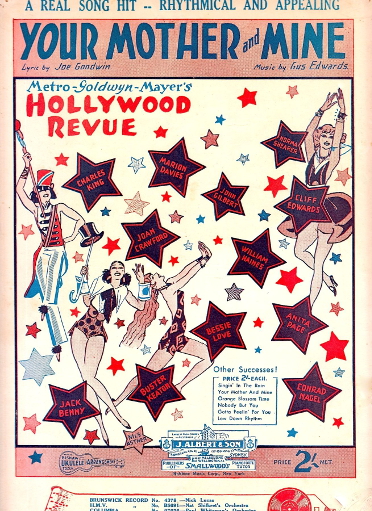
Above: US sheet music (left). And UK sheet music (center and right).
Below left: Grauman's herald cover. Below right: Grauman's program cover. Click here or on photo to see inside pages and back cover.

Above: Magazine ad from Hollywood Filmograph.
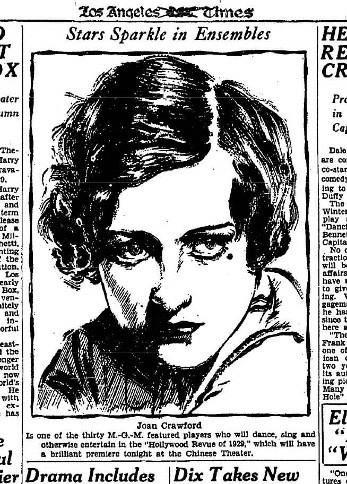
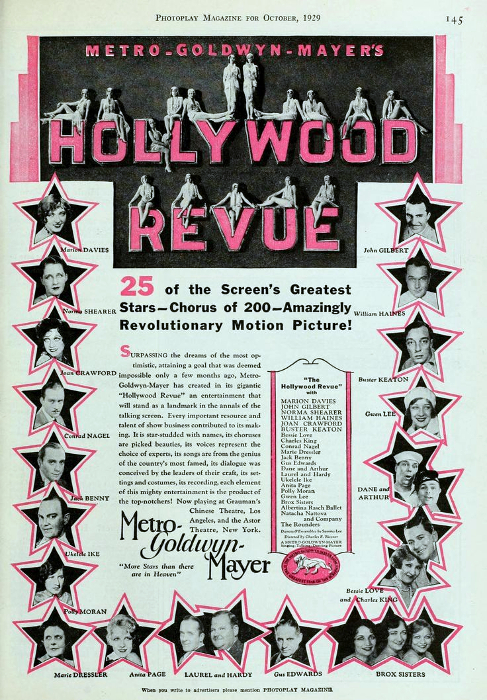
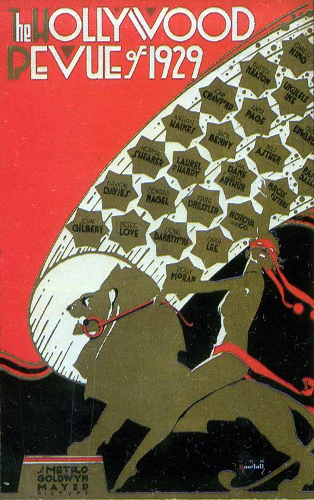
Above left: From the LA Times, June 1929. Above center: Photoplay ad, October 1929. Above right: US theater window card.
Below: US program cover and pages.
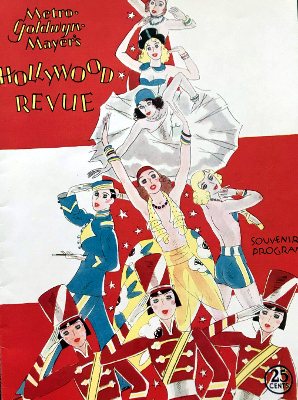

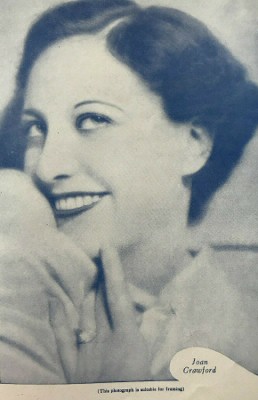
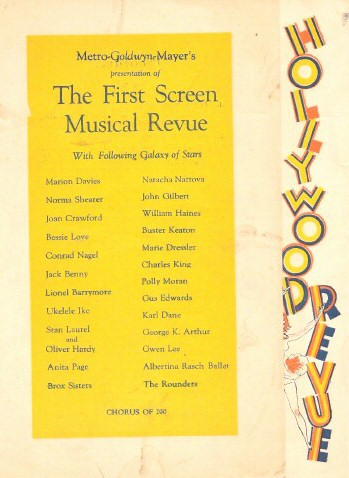

Below: US herald
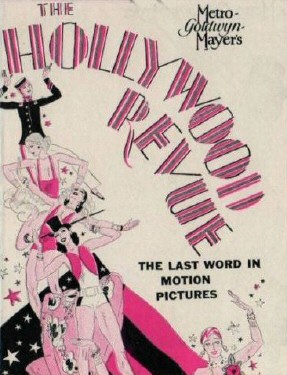
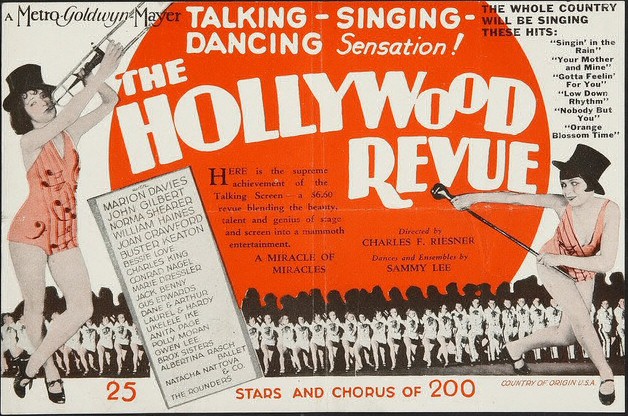
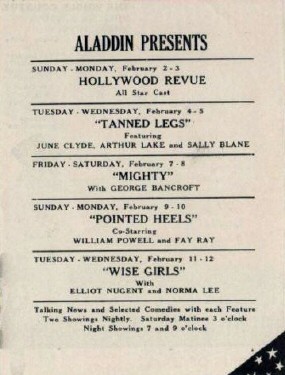
The Best of Everything
